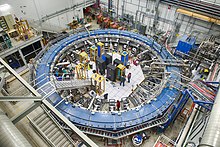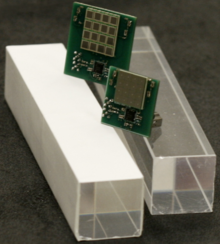Muon g-2

Muon g-2 is a particle physics experiment at the Fermilab with the aim of measuring the Landé factor (g factor) of the muon more precisely. The Landé factor describes the ratio of the strength of the quantum mechanical magnetic field to the expectation from classical physics, for muons the factor is slightly larger than 2. The deviation from 2 should be measured with a precision of 0.14 ppm . Since the expected deviation can be predicted with similar precision, this is an accurate test of the standard model . If the prediction and the measured value do not match, this is an indication of physics beyond the standard model, for example of as yet undiscovered particles. Previous experiments found a slight deviation, but were not sensitive enough to rule out a random fluctuation in the measured value as the cause.
history
The muon's g-factor was measured in several experiments. The most precise measurement to date was carried out at Brookhaven National Laboratory until 2001 . At the Fermilab, this experiment is now to be continued with greater accuracy. For this purpose, the ring electromagnet, the largest part of the experiment, was transported from the Brookhaven National Laboratory over the east coast of the USA and the Mississippi to the Fermilab in 2013 . The magnet was restored and put into operation in September 2015. Tests showed that it survived the transport, the quality of the magnetic field remained the same.
Up until October 2016, shims made the magnetic field even more uniform than before, the typical deviation from the mean value was reduced from 0.14% to 0.02%.
On May 31, 2017, the first muons were introduced into the ring and data taking began.
Landé factor
The Landé factor of charged leptons ( electrons , muons and tauons ) is around 2. The small deviations from this (“anomalous magnetic moment”) can be calculated using quantum field theory . In perturbation theory , g = 2 is the leading order, higher orders lead to small corrections to this value. They can be calculated with high accuracy. For electrons, the prediction and experiment agree with a relative accuracy of better than 10 −12 ; more than 10,000 Feynman diagrams were taken into account for the theoretical prediction . Measurement is more difficult for muons because they decay quickly. Theoretical predictions are also less precise, as quantum chromodynamics play a major role due to the higher muon mass , which cannot be treated here in terms of perturbation theory. New, as yet unknown particles could influence the value, the heavier the lepton, the greater the influence. Muons have 200 times the mass of electrons and are therefore better suited to search for unknown heavy particles despite the more difficult measurements. Measurements of the g-factor and the direct search for new particles in accelerators such as the LHC complement each other . Tauons are even heavier than muons, but too short-lived to reliably measure the Landé factor.
The measurement result of the previous experiment was 3.4 standard deviations from the theoretical prediction. At the Fermilab it will now be investigated whether this was a random fluctuation or whether the value actually deviates from the theoretical predictions of the standard model . Among other things, the number of muons examined is to be increased by a factor of 20.
Structure of the experiment
The central element of the experiment is the superconducting magnet with a diameter of 14 meters, in which an extremely uniform field prevails. (Anti-) muons (μ + ) circle in it before they decay. The positrons generated during the decay are recorded. The Landé factor of the muon can be determined from the spatial and temporal distribution of the detected positrons.
detector

The positrons are 24 PbF 2 - calorimeters measured, which are installed at equal intervals along the inside of the ring. The calorimeters measure the energy of the positrons as well as their arrival time (relative to the muons' injection into the ring). The calorimeters are read out with silicon photomultipliers .
In addition to the calorimeters, the experiment has straw detectors as track detectors . These are mainly used to monitor the position and width of the muon beam and to determine the overall rate of decay.
Magnetic field
In order to measure g-2 with the desired accuracy, the mean magnetic field must be known with a relative precision of 7 · 10 −8 . For this purpose, there are proton nuclear magnetic resonance devices in the ring . 378 of them are permanently installed and permanently measure the magnetic field. In addition, the experiment has a cart with 17 measuring devices with which the magnetic field can be measured anywhere along the ring if there are no muons in the ring. Measurements of the magnetic field with the car and measurements of muon decays alternate, whereby the magnetic field is typically measured once a day for two hours.
collaboration
About 200 scientists from 8 countries take part in the experiment, mostly from the USA and Italy.
Individual evidence
- ↑ Muon g-2 ( en ) Retrieved April 26, 2017.
- ↑ Elizabeth Gibney: Muons' big moment could fuel new physics . In: Nature . 544, No. 7649, April 13, 2017, pp. 145–146. doi : 10.1038 / 544145a .
- ↑ Muon g-2 | Solving a Mystery ( en )
- ^ The Big Move
- ↑ Muon g-2 storage ring starts a new life - CERN Courier ( en ) Accessed August 16, 2017.
- ↑ Wesley Gohn: The Muon g-2 Experiment at Fermilab
- ↑ Muon Magnet's Moment Has Arrived , press release from Fermilab
- ↑ a b FNAL g-2 experiment . Retrieved April 30, 2017.
- ↑ K. Hagiwara, AD Martin, Daisuke Nomura, T. Teubner: Improved predictions for of the muon and . In: Physics Letters B . 649, No. 2-3, May 2007, pp. 173-179. arxiv : hep-ph / 0611102 . doi : 10.1016 / j.physletb.2007.04.012 .
- ↑ JL Holzbauer: The Muon g-2 Experiment Overview and Status as of June 2016 . In: J.Phys.Conf.Ser. . 770, December 9, 2016, p. 012038. doi : 10.1088 / 1742-6596 / 770/1/012038 .
- ↑ a b c J. Grange, V. Guarino, P. Winter, K. Wood, H. Zhao, R. Carey, D. gastler, E. Hazen, N. Kinnaird: Muon (g-2) Technical Design Report . In: Instrumentation and Detectors . 2015, arxiv : 1501.06858 .
- ↑ Muon g-2 | Collaboration ( s )
